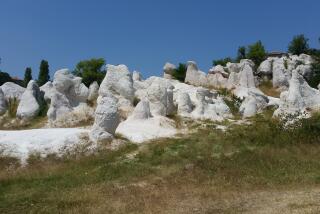Nature, Truth and the Measure of a Mountain
LAKE O'HARA, Canada — Sometimes, you can’t not take it with you.
I was reminded of this recently during a week stalking wildflowers and crunching through glaciers in the wilderness of the Canadian Rockies.
A friend stopped to marvel at the miniature tableau created by the chance alignment of twig, brook, flower, mushroom, moss.
I stopped to marvel at the way gravity had bent a sapling backward into a parabola.
“Just what you would notice,” she said, rolling her eyes.
Even this far from civilization, I couldn’t help packing a certain attitude--a way of seeing things through the eyes of science. Here, in what many experienced hikers consider to be the most beautiful spot in the world, a realm of pure spiritual transcendence, I couldn’t help seeing geology, physics, biology, psychology, and, yes, even math.
To be sure, mountains can move us. But it’s easy to forget that mountains also move, capturing as they do the history of the planet and everything that ever happened on it or to it. Traveling in the mountains is a trek through petrified space-time.
The Canadian Rockies, in particular, have the look of a construction site: colossal fossilized ocean waves, caught in the act of breaking, fierce as sharks’ teeth, menacing as shards of broken glass.
Underneath, the Earth is doing a slow boil. “The Earth’s mountain ranges have been built by nuclear energy,” Ben Gadd reminds us in “The Handbook of the Canadian Rockies.”
The heat released by radioactive decay melts rocks, driving currents that push the continents around. When they plow together, mountains rise up in smooth folds, like a crumpled tablecloth, exposing the layers that were laid down eons ago in the ocean--the sands of time.
The sharp edges come later, with the ice. “I thought glaciers were supposed to move,” said my friend, impatiently watching the fields of snow for signs. “They do,” said I. “Only glacially.”
*
Water is strong stuff. It can chisel stone.
It also does pretty things with optics.
A raindrop hanging from a pine needle forms an upside-down image of the mountains, clouds, lake--a world inside a drop of water.
In the lakes, the color of the water turns intense, almost gaudy. One reason has to do with the uniformity of the size of the particles--”rock flour”--washed off the mountains by the glaciers. The heavier particles sink to the bottom of the still, cold lakes, leaving only the smallest suspended. Like molecules in the air that selectively scatter the blue light of the sun to our eyes, the particles in the lake scatter only aqua-green.
The lakes mirror everything, multiplying limbs of long-dead trees--picked clean by the elements--into skeletons of bizarre creatures. These illusionary life forms look uncannily like the real fossilized remains found in the famous repository known as the Burgess Shale, not far from here.
Captured in the shale is one of the most prolific outpourings of creation the world has ever seen--creatures long extinct, some with five waggling eyes or seven spiky legs.
But then, all life seems bizarre up here in the thin air. Trees grow tall and thin, grasping for breath. They poise precariously on cliffs, bend like elbows, hang upside down, holding on by their roots--a lesson in tenacity.
Miniature mop-headed plant life springs up absurdly by the streams, alien species, something out of Dr. Seuss.
We nearly trip over a couple of marmots sunning on the trail. Marmots adapt to the harsh climate by sinking into something like a near-death experience for seven months of every year; their hearts barely beat, their lungs barely breathe.
There are critters we city people could do without. Bears, for example. A thrill to see at a distance, but a source of terror (at least for me) on the trail. At some level, we like our wilderness as innocuous as Disneyland.
Which brings us to psychology. While I worry about the grizzlies, people here shake in their boots about the thought of coming to L.A. Wild life, like so much else, is a matter of perspective.
And math. What is the probability of getting eaten by a grizzly, anyway? It’s not at all like the probability of getting heads on the toss of a coin. For one thing, the probability of a coin landing heads is not affected by the outcome of previous tosses. However, the probability of running into a bear is most certainly affected by the fact that a bear was seen on this very trail only yesterday.
We discuss the mathematics of probability very LOUDLY so the bears will hear us coming.
There is neuroscience here too--the way the mountains play on our emotions. On his first extended trip to the Sierra, mountaineer John Muir let loose such a “wild burst of ecstasy,” he reports in his diary, that he frightened a bear.
Is it an accident that gods invariably occupy mountaintops?
“Why, after all, should one get excited about a mountain,” asked the essayist Wendell Berry, “when one can see almost as far from the top of a building?”
Why, indeed?
The science may escape us. But the truth is as stubborn as stone: Mountains move us in a way we will never move mountains.
More to Read
Sign up for Essential California
The most important California stories and recommendations in your inbox every morning.
You may occasionally receive promotional content from the Los Angeles Times.










